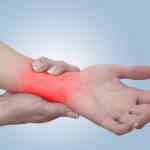Complex Regional Pain Syndrome (CRPS)
What is it?
CRPS is a chronic pain condition which usually means it lasts more than 6 months. It can be referred to by many other names such as Reflex Sympathetic Dystrophy (RSD), Sudeck’s Atrophy, Algodystrophy, causalgia and Abnormal Pain Response.
Who gets it and what causes it?
It usually happens following an injury or rarely following surgery or tight casting. The injury does not necessarily have to be severe.
It is thought to happen due to a communication breakdown or malfunction between the nerves in the affected limb and the brain.
CRPS has been divided into Type-I and Type-II. If there is definitely no associated nerve injury this is Type-I. If there is a nerve injury with the condition, this is Type-II.
CRPS is hardly ever seen in young children or the elderly.
What are the signs and symptoms?

Symptoms can vary between patients and can also change over time within the same patient.
Patients may experience excessive burning pain, swelling and stiffness in the joints. There can be associated changes in skin colour, excessive sweating and temperature changes. The skin and nails may also change in quality. There maybe excessive hair growth and the affected area can be overtly sensitive to touch.
What tests will I need?
The first step is to undergo a consultation, involving a medical history and clinical examination. Mr Naqui may organise further tests such as blood tests, x-ray or MRI scan to rule out other conditions. No one test can diagnose CRPS and it is essentially a diagnosis based upon an assessment of the overall picture.
What is the treatment?
The mainstay of treatment is rehabilitation and expert hand physical therapy. This is reinforced with lots of encouragement and psychological support.
Various mediations, which relieve pain, can be tried to help reduce the pain and encourage hand and wrist movement.
In certain circumstances interventions to stimulate, block or destroy part of the affected nerve can be tried, but these have highly variable outcomes.
The options available will be discussed in detail by Mr Naqui.
When I can return to normal activity?
Recovery from CRPS is highly variable. Young patients tend to do better as do those patients who have early rehabilitation. Recovery can take anything from 6 months to 2 years.
For more information about this condition:





